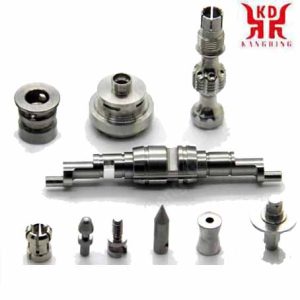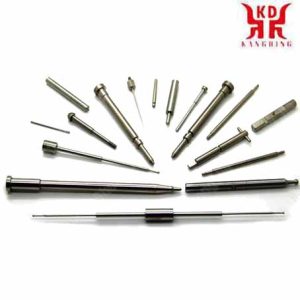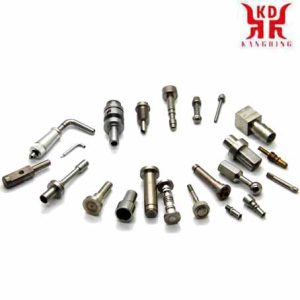மைக்ரோ எந்திரம் என்றால் என்ன? அதன் அளவு நிலையான மற்றும் எந்திர தொழில்நுட்பம்?
மைக்ரோமச்சினிங்: வேலைப்பாடுகளை எந்திரம் செய்வதற்கான சிறந்த நுட்பம், biomedical replicas and high precision parts
Micromachining is a technique that allows small parts to be machined thanks to the high tool speeds that can be achieved. This technique is ideal for machining engravings, biomedical replicas and high precision parts.
Thanks to the micro-machining of engravings, thermo-printing can be done, which allows all types of plastic surfaces to be silkscreened with great durability and a variety of colors (silver and gold) that other similar techniques do not allow.

316LVM பாகங்களின் மைக்ரோமச்சினிங்
Engraving Machining Applications:
– Pieces of reduced dimensions.
– Biomedical replicas.
– Mechanization of small electrodes.
– Mechanization of preforms for thermoimpression.
Advantage:
– Small and unconventional machining.
– Thermal printing in different colors of great durability.
KANGDING has the following micromachining machines: Impala 400, Matsuura LX-0.
Micro-machining technique – get small, high-precision parts
The machining industry has maintained a constant rate of growth and innovation that has allowed it to achieve a privileged position with the rest of the industrial sectors. And it is that it has been through machining that the best results have been obtained for components and parts that the rest of the industrial conglomerate needs to perform its functions, and one of the most outstanding achievements is the development of micromachining.
With the micromachining technique, it is possible to obtain very small elements with high-speed work processes which require great precision. Its use is focused on the medicine, electronics or robotics industry, in addition to the sectors that traditionally use machining such as aerospace, rail or automobile. Today, substantial progress has been made in this area, since screen printing processes have been extended through thermo-printing. Above all, in plastic elements. Likewise, the engraving process is used in the mechanization by thermo-printing of preforms and in biomedical elements through replicas.

High-precision Mitsubishi Needle for Surgery
Advances and advantages of micromachining
The many advantages of micromachining should be highlighted. உதாரணத்திற்கு, the use of lasers to produce components efficiently with a high level of reliability which avoids any failure during the process. In turn, it has the ability to machine extremely hard materials such as carbides, including tungsten and ceramic materials. Due to its small diameter, the laser and the ability to remove a small amount of material can be used for small engraving operations.
The machining industry has managed to evolve in a substantial, constant and permanent way. An example of this is the development of new, much more resistant tools that are applied to a greater extent to extremely hard materials such as ceramics and hardened steels. In these cases, the tools must be extremely sharpened diamonds with a monocrystalline structure, which in turn can be obtained as components through micromachining.
தற்போது, a multidisciplinary project is being carried out that has been specifically developed to machine components through micromachining in the hardest materials. Its main objective is focused on increasing the precision margin in the work of the machine tool. In this, it has been complemented with special drives and the implementation of hydrostatic guides with which a higher concentration can be obtained before starting the part cutting process. The use of ultrasonic waves allows diamond cutting tools to be lifted only a few micrometers in the same direction of the cut in a process of almost 40,000 times per second.

Fine titanium alloy needles for surgical instruments
Within the conventional ultra-precision micromachining, KANGding is basically committed to two technologies: ultra-precision micromilling and turning with diamond tools.
Micro-milling, in contrast to conventional milling, is based on the removal of material with very small tools (diameter between 50µm and 3mm). As previously mentioned, micro-milling is a flexible and fast technology for the manufacture of components with features with dimensions ranging from a few tens of microns (very delicate), to a few millimeters, in a wide range of materials (alloys metals, composites, polymers and ceramics), its field of application being very extensive and varied (molds for micro-injection, components for optics, விண்வெளி, electronics and biomedical industries).
Likewise, the micro-milling process represents an important conceptual change in relation to conventional milling, due to the reduced dimensions of the cutting tools and the chip formation process. In this sense, உதாரணத்திற்கு, the so-called “size effect” is palpable, typical of tool cutting processes that process very small volumes of material (there is no direct scaling from macro to micro milling in terms of process parameters ). This effect, together with the need for a minimum chip thickness to eliminate it, the heterogeneities of the material to be machined, the appearance of burrs of a very large size in relation to the size of the features to be machined (all effects, in general, of almost zero importance in conventional milling), have a significant importance in the performance of the micro-milling process. The effect of tool wear and bending on tool breakage and on the quality of the final part are also of special relevance.
Diamond turning, on the other hand, is a process oriented from its beginnings to the investigation of non-ferrous metal machining (the affinity of iron with carbon causes the decarburization of diamond tools, making these tools not suitable for the machining of ferrous materials), such as aluminum and bronze, for electronic applications and, fundamentally, optics (eg, molds for serial production of lenses), given the ability it offers to obtain “specular” finishes (roughness of a few nanometers ).
 English
English العربية
العربية 中文(漢字)
中文(漢字) Čeština
Čeština Dansk
Dansk Nederlands
Nederlands Suomi
Suomi Français
Français Deutsch
Deutsch Italiano
Italiano 日本語
日本語 ಕನ್ನಡ
ಕನ್ನಡ 한국어
한국어 Português
Português Русский
Русский Slovenčina
Slovenčina Español
Español Svenska
Svenska Türkçe
Türkçe

